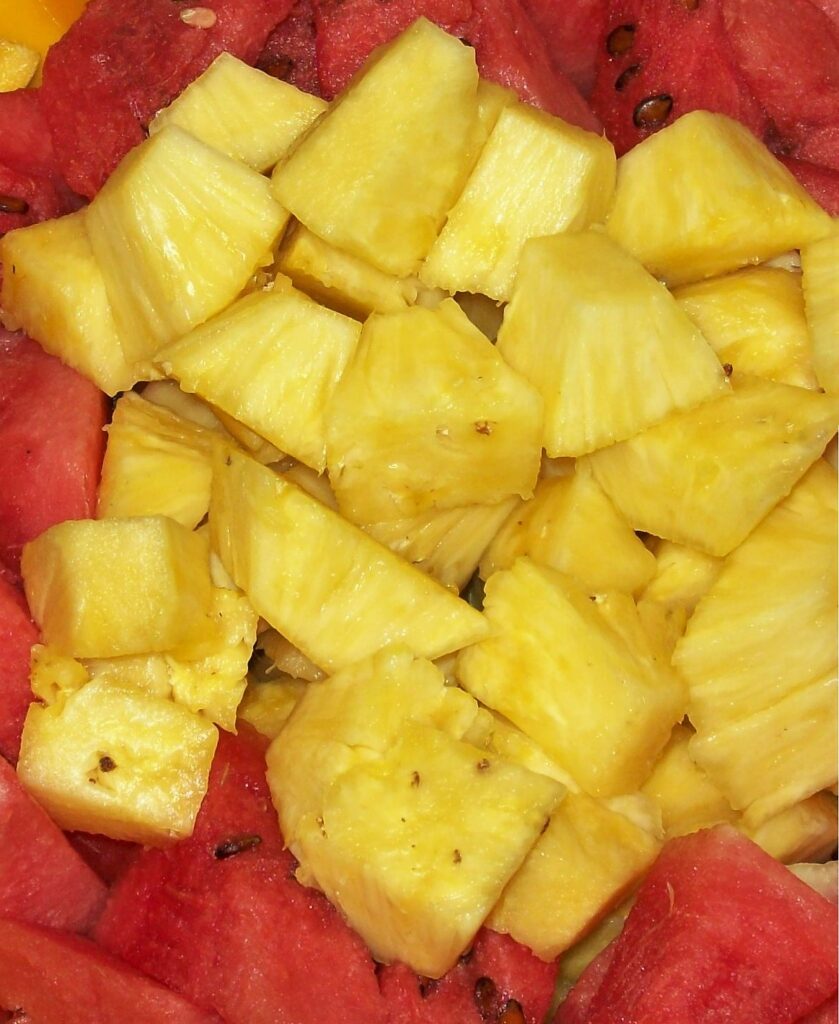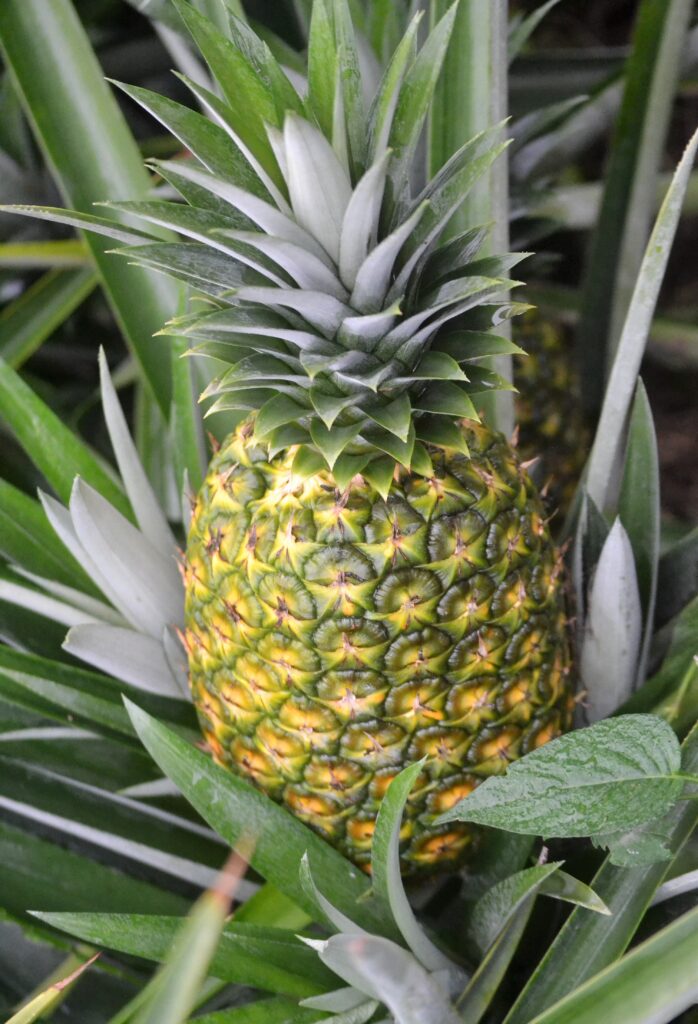Text and Photos by Evangeline T. Capuno
Pineapple is believed to have originated from Brazil, where tribal peoples have always regarded pineapple highly, and have used it as a staple food and as an ingredient in some wines. When early explorers brought the pineapple back to Europe, its sweetness and unusual appearance made the fruit a symbol of royal privilege.
Being popular in Europe, the Spaniards (who carved pineapples over doorways) brought the fruit to the Philippines, where it has become naturalized since then. Today, the Philippines is one of the world’s leading pineapple exporters.
Aside from being eaten raw, pineapple is also added to fruit salad, pies, cakes, ice cream, yogurt, punches, and other desserts. It is an ingredient in most sweet and sour dishes, and is used in many savory dishes.
Bromelain in pineapples
Throughout all this history, pineapple was valued strictly as a table delicacy. All but forgotten were the early explorers’ intriguing observations that Indians had used pineapple poultices to reduce inflammation in wounds and other skin injuries.
Then, in 1891 an enzyme called bromelain was isolated from the flesh of the pineapple and was discovered to be proteolytic – that is, it breaks down protein. Hence it is a natural meat tenderizer (the pineapple rings atop a baked ham are not there just for the flavor) as well as a digestive aid. It can also break down blood clots — proteins are what hold blood platelets together to form clots — and clean away the dead tissue left by burns, abscesses, ulcers, and various kinds of surgery. Bromelain also has proved effective in killing parasites such as worms.
Studies have shown that bromelain in pineapples can interfere with the preparation of some foods, such as jelly or other gelatin-based desserts. The bromelain breaks down in the canning process, thus canned pineapple can generally be used with gelatin.
Just a word of warning: Bromelain can be hazardous to someone suffering from certain protein deficiencies or disorders, such as Ehlers-Danlos syndrome. Pineapples should also not be consumed by those with hemophilia or by those with kidney or liver disease, as it may reduce the time taken to coagulate a consumer’s blood.

Meanwhile, the medical properties of pineapple have been the subject of interest among noted herbalists and physicians of old, who have recommended them for their dietary and remedial virtues, with a certainty based on custom, observation and limited scientific knowledge.
Medical advantages of pineapple
Pineapple is one of those fruits that people should eat regularly, as it is rich in vitamins, enzymes and antioxidants. Medical News Today reported that one cup of fresh pineapple chunks contains approximately 82 calories, 0.2 gram of fat, 2 milligrams of sodium, 21.65 grams of carbohydrates (including 16 grams of sugar and 2.3 grams of fiber), and 0.89 gram of protein. You don’t get any cholesterol from eating pineapple.
As a percentage of a person’s daily requirements, the same amount of fresh pineapple chucks provides 131% of vitamin C, 2% of vitamin A, 2% of calcium, and 3% of iron. The fruit is also a source of the following vitamins and minerals: thiamin, riboflavin, vitamin B6, folate, pantothenic acid, magnesium, potassium, and beta carotene and other antioxidants.
Pineapple is also an essential fruit for treating diarrhea. “Studies indicate that pineapple plays a significant role in alleviating diarrhea and ameliorating gut health in individuals,” explains Jen Miller, author of an article, “Health Benefits of Pineapple Based on Science.” “Treating diarrhea as well as preventing such gut infections that cause bloating, vomiting and gas in children and adults can be administered with the help of pineapple which is high in antioxidants and dietary fiber.”

Eating pineapple regularly can also reduce blood clots. “Regular intake of bromelain enzyme is generally administered to regulate proper blood flow from system to system in the human body,” Miller writes. “Blood clots are characterized by the body’s natural response to treating injured blood vessels.”
Some research has suggested that bromelain in pineapple can help to reduce the risk of cardiovascular conditions such as thrombosis. “However, more research is required before a clear link between pineapple and heart health can be established,” reminds Nicola Shubrook, an accredited member of the British Association for Applied Nutrition and Nutritional Therapy.
As pineapple contains no fat or cholesterol, it is also good for those who want to lose weight. “Pineapple contains high amounts of dietary fiber that positively affect weight loss and weight management in individuals,” Miller writes. “Any fruits that increase the body’s fat-burning capacity are metabolism boosters. Pineapple is one such tropical fruit high in nutrients that regulate fast recovery and metabolic activities.”
But what is most interesting about pineapple is that they may help inhibit the growth of harmful cancer cells. “With the combination of vitamin C and other healthy antioxidants that pineapple contains, different types of cancer including stomach cancer, breast cancer and colon cancer may be prevented,” Miller states.
Vitamin C plays a big part in hindering some cancers. “Vitamin C is proven to restrict the formation of carcinogenic compounds that are directly related to stomach cancer and gastric cancer,” Miller writes. “It also helps fight the kind of bacteria that causes stomach cancer due to vitamin C deficiency.”
Antioxidant-rich pineapple has been shown to improve both male and female fertility. “The leading cause of infertility is oxidative stress,” Miller points out. “Free radical damage dramatically affects the reproductive organs. Other factors [contributing to infertility] include eating disorders, smoking, age-related effects, and an unhealthy lifestyle. All these factors also influence oxidative stress in the body.” All the damage caused by oxidative stress can be counteracted by pineapple consumption, as it contains most of the essential vitamins and minerals. “All nutrients (found in pineapple) play an important role in reducing oxidative stress in the reproductive system,” Miller stresses.
When unripe, the pineapple is not only inedible but poisonous, irritating the throat and acting as a drastic purgative. Excessive consumption of pineapple cores has caused the formation of fiber balls (bezoars) in the digestive tract.
However, women who want to get pregnant should not eat pineapple. In some parts of the world, the flesh of very young fruits is deliberately ingested to achieve abortion (a little with honey on 3 successive mornings). – ###








